Join More Than 50,000+ Subscribers and get latest camera news and rumors
NEW CAMERA VIDEOS ON YOUTUBE
|
By admin, on March 27th, 2025
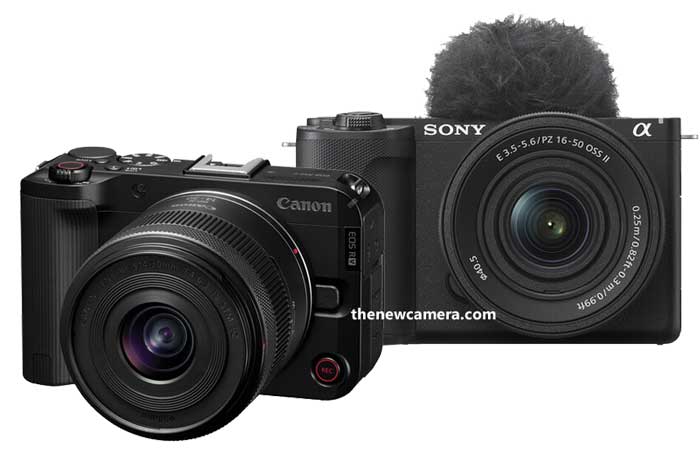
Canon R50V vs Sony Z10 Mark II. Let’s discuss the major differences between the two, then we will do some deep core specification analysis so you can understand very clearly which camera you should buy.
Canon R50 V Specifications and Pricing
Initially, the Canon R50 V camera is available with a 24-megapixel DPAF CMOS sensor, the same sensor that is being used by entry-level cameras such as Canon R50 and Canon R10. If you buy it with a kit lens, you have to pay approximately $849, and when you are buying the body only, you have to pay approximately $649.
Sony Z10 Mark II Specifications and Pricing
Now, the Sony Z10 Mark II camera was released on July 10, 2024, and uses a 26-megapixel APS-C BSI CMOS sensor from FX30 or Sony A6700 camera, meaning it’s a flagship sensor. With a kit lens, you have to pay $1,099, and without a kit lens, you have to pay only $999.
So, the Canon body is a lot more affordable compared to the Sony Z10 Mark II camera. Now, let’s dive deep into the detailed core specifications of both cameras.
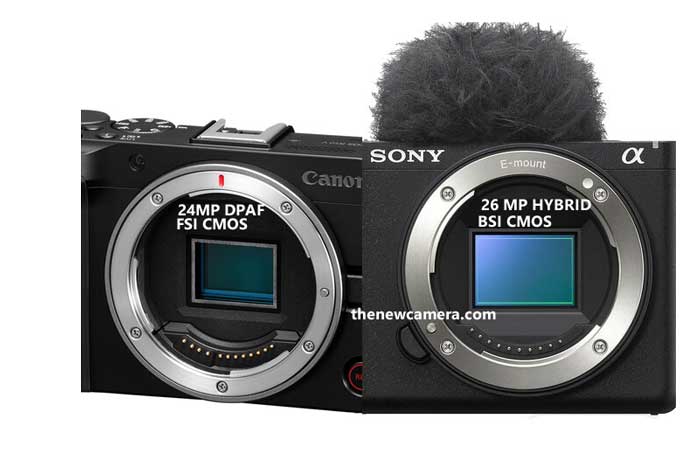
Key Differences in Sensor Technologies
So, initially, we have some basic differences between the two. The Canon uses an FSI CMOS sensor with a resolution from entry-level models, and the Sony Z10 Mark II uses a BSI CMOS sensor from higher-end models. Along with that, we also have a price difference between the two.
Best Camera for Recording 4K 60p Video

Crop Factor Comparison
If you compare both the Canon R50 V and Sony ZV-E10 Mark II, the advantage of the Sony ZV-E10 Mark II camera is clearly visible as it does only a 1.1x crop while recording 4K 60p video. On the other side, we have the Canon R50 V camera, which does a 1.5x crop while recording 4K 60p video. Both cameras allow you to record 10-bit videos at 4K 60p, but at the same time, you have to face a crop in Canon.
Usability and Stabilization
Usability-wise, the Sony ZV-E10 Mark II camera is more usable since, even while recording 4K 60fps with a crop, we can utilize the Active SteadyShot mode as well as the gyro-based image stabilization mode. If you are shooting handheld videos, that will, in turn, help you get stable footage without a gimbal. The electronic image stabilization (EIS) is very effective when you are using it at 30fps or 24fps recording. However, since it already has a very significant 1.5x crop, it doesn’t work that well.
Final Recommendation Best Camera for high-speed 4k videos
So, overall, for 4K 60fps recording, we highly recommend you to get the Sony ZV-E10 Mark II camera. Codec and Color Depth in Both Cameras
Video Codecs
Canon R50 V Video Capabilities
Now, with a 24-megapixel FSI CMOS sensor, our recently announced Canon R50 V camera is able to record 10-bit 4:2:2 videos in H.265 or H.264 codec. You can also record your videos in Canon Log 3 as well as in HLG HDR modes—all these features are available in this entry-level model.
Sony Z10 Mark II Video Capabilities
With a 26-megapixel BSI CMOS sensor, Sony does the same. It also records 10-bit 4:2:2 videos in XAVC HS (H.265) and XAVC S (H.264). Additionally, it supports S-Log2, S-Log3, and Hybrid Log Gamma (HLG), offering up to 14 stops of dynamic range.
Video codec – Comparison and Conclusion
So, in terms of video codec, both cameras record the same 10-bit videos, and neither of them has any limitations over log profiles or any other video codec restrictions. In terms of usability for beginners, videographers, and content creators, both cameras perform well. We are not discussing professional use at this moment.
Detailed Video Specifications Comparison Table
| Feature |
Canon R50V |
Sony ZV-E10 Mark II |
| Max Video Resolution |
4K 60p (cropped, crop factor unspecified), 4K 23.98p (assumed uncropped based on preview) |
4K 60p (1.1x crop), 4K 30p/24p (uncropped, oversampled from 5.6K) |
| Full HD Capabilities |
1080p up to 120p (implied from slow-motion options) |
1080p up to 120p |
| Video Codecs |
H.265, H.264 (10-bit 4:2:2 internal with log) |
XAVC HS (H.265), XAVC S (H.264) (10-bit 4:2:2 internal) |
| Color Profiles |
C-Log, custom picture profiles from Canon cinema series |
S-Log2, S-Log3, HLG, Creative Looks (e.g., cinematic presets) |
| Bit Depth |
10-bit internal recording |
10-bit internal recording |
| Dynamic Range |
Not specified (likely ~12-14 stops with C-Log, based on Canon APS-C trends) |
Up to 14 stops with S-Log3 |
| Streaming |
4K 60p via USB-C (dedicated quick streaming button) |
4K 30p via USB-C (UVC/UAC support, improved from original’s 720p) |
| Slow Motion |
Supported with option to bake in or exclude audio (specific frame rates not detailed) |
1080p 120p, 4K 60p slo-mo with 2x playback (no audio baking options specified) |
| Recording Limit |
Not specified (likely no limit based on Canon trends) |
No recording time limit (improved thermal management over original) |
| Overheating |
Not specified (DIGIC X typically manages heat well, no issues noted in preview) |
Improved over ZV-E10 but can overheat after ~20-30 mins in 4K 60p at high ambient temps |
| Autofocus in Video |
Dual Pixel AF II (fast, reliable tracking, eye/face detection) |
Fast Hybrid AF with Real-time Eye AF, Tracking, Product Showcase mode (495 phase-detect points) |
| Stabilization |
No IBIS, relies on lens IS (e.g., 14-30mm PZ) or digital stabilization (crops further) |
No IBIS, Active SteadyShot (digital, ~1.1x crop), lens OSS support |
| Cinematic Features |
“Peter McKinnon mode” (baked-in cinematic bars), power zoom lens support |
Background Defocus button, vertical shooting metadata, Cinematic Vlog mode |
| Crop Factor in 4K |
Cropped in 4K 60p (extent unspecified), uncropped in 4K 23.98p (assumed) |
1.1x crop in 4K 60p, uncropped in 4K 30p/24p |
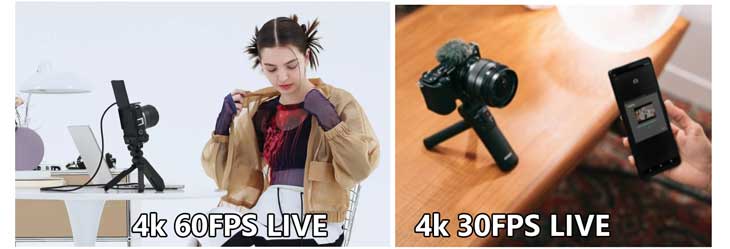
Best Camera for Live Streaming
Canon R50 V Live Streaming Capabilities
The recently announced Canon R50 V supports streaming up to 4K 60fps via USB-C, but at the same time, you have to consider the fact that it still has a 1.5x crop. This means you need to use ultra-wide-angle lenses when placing the camera in front of you.
Sony ZV-E10 Mark II Live Streaming Capabilities
On the other hand, in the Sony ZV-E10 Mark II, video streaming or USB streaming remains limited to 4K 30fps via UVC/USC.
Best Camera for Live Streaming
So, you can consider the Canon R50 V as a clear winner in terms of streaming capability, but it also suffers from a crop limitation, which you need to keep in mind while choosing between these two cameras.
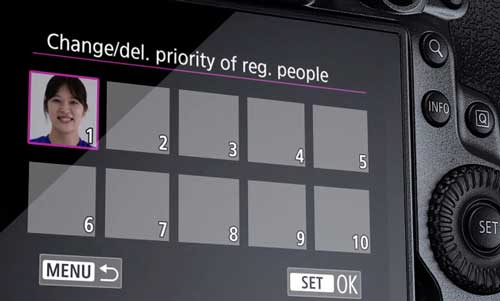
Canon R50V Autofocus Capabilities
Canon R50V camera uses a Dual Pixel CMOS autofocus sensor paired with DIGIC X image processor, and according to Canon’s official press release, they are using the same autofocus AF algorithm as they have used in the Canon R5 Mark II camera. The camera also includes subject tracking modes, which include birds, animals, airplanes, moving vehicles, as well as one of the most important modes that has been added to this camera—face registration. Here, you can technically register one, two, or multiple faces, and even in a crowd when you are creating a video sequence, like when you’re doing wedding cinematography. Then, even in a crowd, if you have already registered the bride and groom’s faces in the camera, it will track only those two.
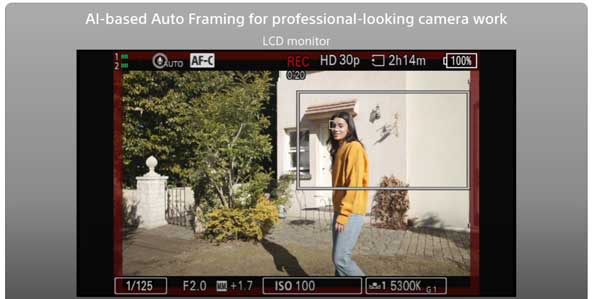
Sony ZV-E10 Mark II Autofocus Capabilities
Now, in the Sony ZV-E10 Mark II camera, we have an advanced video autofocus tracking mode, which is directly coming from the Sony A7R V. It does have predictive AI tracking, just as we have seen in higher-end Sony models, so it is also very good at predicting human faces, human bodies, animals, birds, and eyes. Moreover, the camera also has a built-in AI auto-framing mode, which, in turn, the Canon R50 V doesn’t have. This particular AI auto-framing mode helps content creators, especially solo content creators—those who create cooking videos in a single room. The camera will automatically track them and crop them in a frame, like the way a professional cinematographer shoots their movement.
Best Camera with Usable AF in Video
So, each of these cameras does have brilliant autofocus tracking capability and some specialized modes. The Canon R50 V is more suitable for wedding cinematography, where you can register people’s faces for autofocus tracking, whereas in the Sony ZV-E10 Mark II camera, we have AI auto-framing mode, which is more useful for content creators.
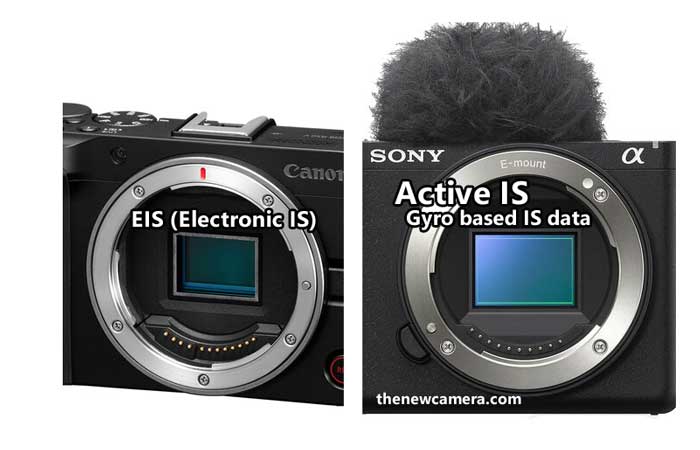
Canon R50 V Image Stabilization
Canon R50 V camera is a base model, and we are not able to expect too much out of it. Since the absence of sensor-shift image stabilization looks a bit logical to me, any camera maker out there is not offering any sort of IBIS mechanism in that price range. Although the camera does have EIS (Electronic Image Stabilization), which is effective for video, you have to use ultra-wide-angle lenses when you are using EIS in the camera for creating content or shooting any sort of videos. But keep in mind that EIS is only effective in shooting videos, not in still photography.
Sony ZV-E10 Mark II Image Stabilization
Sony ZV-E10 Mark II camera comes at a higher price, and at least we were expecting the presence of some sort of IBIS feature inside it. But for video recording purposes, we do get Active I.S. inside this camera, supported with a gyro-based image stabilization system. So, specifically, when you are using gyro, you get very stable footage with minimal crop, but you have to post-process it on your laptop or PC using Sony Catalyst Browse software. Other than that, we have Active I.S. mode, where Sony does crop significantly, but we do get gimbal-like stable footage from the camera.
Best camera for Handheld Video
So overall, none of the cameras feature sensor-shift image stabilization systems, but in the Sony ZV-E10 Mark II camera, we do have gyro-based image stabilization as well as Active Mode, which is very effective. Price-wise, what we are getting in Canon R50 V also looks very logical to me, specifically if you are into content creation. So, it’s very obvious that if you are paying a bit higher price for a camera body like the Sony ZV-E10 Mark II, you will get better image stabilization performance, which is specifically made for videographers and cinematographers.
Audio Specifications
| Feature |
Canon R50V |
Sony ZV-E10 Mark II |
| Microphone Port |
Yes (3.5mm) |
Yes (3.5mm) |
| Headphone Port |
Yes (3.5mm) |
Yes (3.5mm) |
| Onboard Microphone |
Standard stereo mic (not emphasized as vlogging-specific) |
Directional 3-capsule mic with windscreen (optimized for vlogging, improved over original) |
| Digital Audio Support |
Digital hot shoe (24-bit, 4-channel audio with compatible Canon mics) |
Multi-interface shoe (digital audio with compatible Sony mics, e.g., ECM-W2BT) |
Body Design & Battery Life
Body design-wise, both cameras are the same, and even the weight is almost equal, at under 400 grams. However, in the Sony ZV-E10 Mark II camera, we get a deeper hand grip as well as a battery life similar to that of a full-frame camera. The NP-FZ100 battery is capable of giving you approximately 610 shots and more than 2 hours of continuous 4K 30p video recording.
Body Design
| Feature |
Canon R50V |
Sony ZV-E10 Mark II |
| Dimensions |
116 x 86 x 69 mm |
121 x 68 x 54 mm |
| Weight |
Not specified (likely ~375g with battery, based on R50) |
377g (with battery and SD card) |
| Viewfinder |
None (EVF omitted to reduce cost) |
None |
| Screen |
3-inch vari-angle LCD (lower resolution than R50, exact dots unspecified) |
3-inch fully articulated LCD (1.04M dots, touch-capacitive) |
| Tally Light |
Yes (front-facing, with red box on screen) |
Yes (front-facing, improved visibility over original) |
| Vertical Video Support |
Quarter-20 mount on side for vertical tripod/gimbal use |
Vertical shooting metadata (no physical mount, relies on software orientation) |
| Weather Sealing |
None |
None |
| Ergonomics |
Not detailed (likely similar to R50 with deep grip) |
Larger grip than original ZV-E10, two control dials (top and rear) |
| Buttons/Dials |
Quick streaming button, standard Canon layout |
Background Defocus, Photo/Video/S&Q toggle, customizable Fn button |
Ports and Connectivity
| Feature |
Canon R50V |
Sony ZV-E10 Mark II |
| USB |
USB-C (supports streaming and charging) |
USB-C 3.2 Gen 1 (supports streaming and charging) |
| HDMI |
Not specified (likely micro HDMI based on R50) |
Micro HDMI (Type D) |
| Microphone Port |
Yes (3.5mm) |
Yes (3.5mm) |
| Headphone Port |
Yes (3.5mm) |
Yes (3.5mm) |
| Remote Port |
Yes (2.5mm) |
No (remote via Bluetooth or USB) |
| Hot Shoe |
Digital hot shoe (24-bit, 4-channel audio support) |
Multi-interface shoe (digital audio support) |
| Wireless |
Wi-Fi (version not specified), Bluetooth (assumed based on R50) |
Wi-Fi (2.4 GHz), Bluetooth 5.0 |
Battery and Storage
| Feature |
Canon R50V |
Sony ZV-E10 Mark II |
| Battery Type |
LP-E17 (same as R50) |
NP-FZ100 (larger capacity than original ZV-E10’s NP-FW50) |
| Battery Life (CIPA) |
Not specified (likely ~230 shots based on R50) |
610 shots (significant improvement over ZV-E10’s 440 shots) |
| Charging |
USB-C charging supported |
USB-C charging supported (faster charging with PD support) |
| Storage |
Single SD slot (UHS-II) |
Single SD slot (UHS-II support, faster than ZV-E10’s UHS-I) |
In contrast, the Canon R50 V camera uses the regular LP-E17 battery, which offers approximately 230 shots and around 1 hour and 20 minutes of 4K 30p video recording.
Still Photography & Sensor Comparison
For still photography, the Canon R50 V camera uses a 24-megapixel FSI CMOS sensor and supports up to 12 FPS with an Electronic First Curtain Shutter (EFCS) and approximately 15 FPS with an electronic shutter.
Whereas in the Sony ZV-E10 Mark II camera, we have a 26MP BSI CMOS sensor with a maximum continuous shooting speed of 11 FPS, limited to an electronic shutter only. Technically, having an EFCS sensor-based camera is a better option if you’re planning to shoot sports or wildlife photography.
As we all know, Canon’s 100-400mm lens is also available at a budget-friendly price, making it a great pair for those into sports and wildlife photography, as well as content creation. However, at the same time, we must consider the advantage of a 26MP BSI CMOS sensor.
| Feature |
Canon R50V |
Sony ZV-E10 Mark II |
| Resolution |
24MP |
26MP |
| Burst Shooting |
15 fps (electronic), 12 fps (electronic first curtain) |
11 fps (mechanical/electronic) |
| RAW Support |
Yes |
Yes (Compressed/Uncompressed) |
| Image Stabilization |
None (lens-based only) |
None (lens-based only) |
Best Camera for Still Shooters
If you are not into sports and wildlife photography and are looking for higher detail, better low-light performance, and enhanced dynamic range, then getting a 26MP sensor will be a better decision.
Final Conclusion: Which Camera is Best for You—Canon R50 V or Sony ZV-E10 Mark II?
Tailored for Videographers & Content Creators
Both of them are custom-tailored for videographers or content creators, and the best part is Canon is offering us a 10-bit video recording mode in a budget body. But at the same time, we do have some limitations, like having a 1.5x crop in 4K 60 FPS mode. Other than that, we also have limitations in the Canon RF mount, which actually limits us in selecting budget lenses.
Canon Lens Availability & Limitations
So even if you have purchased a budget body from Canon, then it will be a bit hard to find a usable prime lens within budget. Specifically, if you have purchased the Sony ZV-E10 Mark II camera by paying a bit higher price, you can use lenses like Viltrox Air series, which come at a very low price with usable high-grade optics.
Choosing Based on Personal Requirement
But again, it all depends upon your own personal requirement and usage. If you have already sorted out the best lenses that you are going to use for the Canon R50 V camera and having a crop in 4K 60 FPS mode doesn’t bother you, then without a doubt, the R50 V is much more usable for you.
Advantages of Sony ZV-E10 Mark II
Similarly, in the Sony ZV-E10 Mark II camera, we are getting uncropped 4K 60 FPS mode, we are getting active image stabilization as well as AI autofocus and ZV-E10’s in-body stabilization, plus some extra features and extra battery life in the Sony camera. The most important factor is the range of lenses available for the ZV-E10 Mark II.
Final Verdict
So for me, the best budget camera is the Canon R50 V, but if you consider lens availability, then you have to spend a lot more to get perfect Canon lenses for your camera.
Decision-Making Pros and Cons Table: Canon R50V vs Sony ZV-E10 Mark II
Sony ZV-E10 Mark II B&H | Amazon.com
Canon R50V Camera available at B&H Store | Adorama.com | amazon.com
| Category |
Canon R50V |
Sony ZV-E10 Mark II |
| Price |
 Lower cost at $649 body-only or $849 with kit lens – excellent value for features. Lower cost at $649 body-only or $849 with kit lens – excellent value for features.
 Limited native RF-S lens options can increase long-term costs. Limited native RF-S lens options can increase long-term costs.
|
 Reasonable at $999 body-only or $1,099 with kit lens for upgraded specs. Reasonable at $999 body-only or $1,099 with kit lens for upgraded specs.
 Significantly more expensive than R50V, less budget-friendly. Significantly more expensive than R50V, less budget-friendly.
|
| Video Resolution & Frame Rates |
 4K 60p (1.5x crop) for smooth motion, great for action or dynamic vlogging. 4K 60p (1.5x crop) for smooth motion, great for action or dynamic vlogging.
 Uncropped 4K 23.98p for cinematic wide shots. Uncropped 4K 23.98p for cinematic wide shots.
 1080p 120fps for slow motion. 1080p 120fps for slow motion.
 1.5x crop in 4K 60p narrows field of view, requiring wider lenses. 1.5x crop in 4K 60p narrows field of view, requiring wider lenses.
|
 4K 60p (1.1x crop) with less restrictive crop than R50V. 4K 60p (1.1x crop) with less restrictive crop than R50V.
 Uncropped 4K 30p/24p (oversampled from 5.6K) for detailed wide-angle shots. Uncropped 4K 30p/24p (oversampled from 5.6K) for detailed wide-angle shots.
 1080p 120fps for slow motion. 1080p 120fps for slow motion.
 None. None.
|
| Battery Life |
 LP-E17 battery, USB-C charging – decent for short shoots. LP-E17 battery, USB-C charging – decent for short shoots.
 Likely ~60-90 mins 4K recording – shorter than Sony. Likely ~60-90 mins 4K recording – shorter than Sony.
|
 NP-FZ100 battery – ~130 mins 4K recording, significantly longer runtime. NP-FZ100 battery – ~130 mins 4K recording, significantly longer runtime.
 USB-C charging with PD support. USB-C charging with PD support.
|
| Lens Ecosystem |
 RF-S mount with RF compatibility – access to high-quality lenses. RF-S mount with RF compatibility – access to high-quality lenses.
 Limited native APS-C lenses – fewer affordable options. Limited native APS-C lenses – fewer affordable options.
|
 E-mount – vast range of APS-C and full-frame lenses, including third-party. E-mount – vast range of APS-C and full-frame lenses, including third-party.
 Kit lens (16-50mm) less versatile for video than Canon’s PZ lens. Kit lens (16-50mm) less versatile for video than Canon’s PZ lens.
|
Also see Canon R50V vs Sony ZV-E10
By admin, on July 10th, 2024
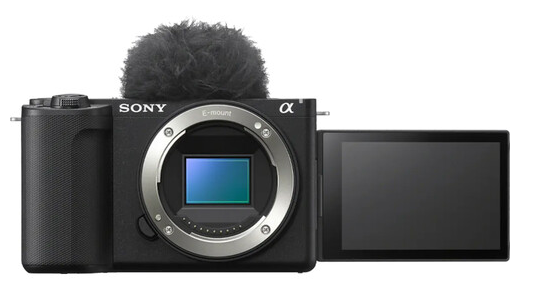
Sony Electronics Announces the Next-Generation ZV-E10 II and E PZ 16-50mm F3.5-5.6 OSS II Lens Kit
Sony ZV-E10 Mark II Pre-order Page at B&H Store
Key Camera Specifications
- 26-megapixel (MP) Exmor R™ CMOS sensor
- BIONZ XR™ image processing engine
- 759-point Focal Plane Phase-detection AF with Real-time Eye AF for Human/Animal/Bird and Real-time Tracking
- ISO range from 100 to 32000
- 5.6K oversampling for 4K footage at up to 60p
- Active Mode electronic image stabilization
- Upgraded large-capacity Z battery (NP-FZ100) allowing continuous movie recording for up to 195 minutes per charge
- APS-C interchangeable lens camera compatible with over 70 Sony E-mount lenses
- Weight: approximately 377 grams
Additional Features to Streamline Content Creation
- Cinematic Vlog Setting
- Vertical User Interface (UI) for vertical content creation
- 4K 60p capture and up to 120p in clear XAVC-S Full HD quality
- Product Showcase Setting
- Background Defocus Function
- Face Priority Auto-Exposure
- Soft Skin Effect
- USB 3.2 Type-C® port for high-speed wired transfer
- Time-lapse sequence creation
- Advanced 3-capsule microphone with selectable directivity
- Wind noise reduction windscreen
- Multi-interface (MI) shoe
- 5 GHz Wi-Fi connectivity for livestreaming
- Screen Reader function and menu Magnify Display for accessibility
Main Features of the Versatile E PZ 16-50mm F3.5-5.6 OSS II Lens
- Compact APS-C power zoom lens
- High-resolution performance with four aspherical elements and one ED (Extra low Dispersion) element
- Minimum focusing distance of 9.8 inches (wide) / 11.8 inches (tele)
- Maximum magnification of 0.215x
- Retractable to approximately 1.25 inches when powered off
- Lightweight: approximately 3.8 oz. (107 grams)
- Built-in optical stabilization
- Supports in-body breathing compensation
The Newest APS-C Camera in Sony’s ZV Series Brings Highly Requested Features and Updates to the Top-Selling Mirrorless Camera
SAN DIEGO, July 10, 2024. Sony Electronics launches the ZV-E10 II, the second generation of the top-selling mirrorless ZV-E10 camerai. The original ZV-E10 is a staple APS-C camera in Sony’s ZV content creation camera series, designed to provide an easy, compact, and versatile tool for content creators of any level. The new ZV-E10 II maintains all the features creators love about the original, such as Creative Looks, Product Showcase Setting, Background Defocus function, and the vari-angle flip screen – and builds on it to increase sophistication and ease of use.
The ZV-E10 II’s internal hardware has been improved from its predecessor with an upgraded 26-megapixel (MP) (approx. effective) Exmor R™ CMOS sensor and adoption of Sony’s latest BIONZ XR™ image processing engine. A few additional updates to this model include improved autofocus and video capturing capabilities: Cinematic Vlog Settingii, a new vertical format user interface (UI), an upgraded large-capacity Sony Z battery for improved stamina and improved connectivity for easy live streaming and data transfer. Staying true to the ethos of the ZV Series, this camera has been redesigned to streamline the content creation process even further, enabling creators to focus less on camera settings and more on their art and creativity. It is compact and lightweight and fits into a creator’s hand with ease, weighing in at approximately 377 gramsiii.
In addition, the E PZ 16-50mm F3.5-5.6 OSS II (SEL1650/2) is announced, a compact APS-C power zoom lens which will be available separately or as part of the ZV-E10 II’s camera kit. The upgraded kit lens is lightweight and offers improved autofocus (AF) and video performance compared to the first-generation model.
“From the beginning, the goal of the Sony ZV line was to create cameras that produced high-quality results while being extremely easy to use. Today, the ZV line continues to uphold that standard, but we’re taking it a step further,” says Yang Cheng, Vice President, Imaging Solutions, Sony Electronics Inc. “Our aim with the advancements of the ZV-E10 II is to inspire creators to develop or recreate their own unique style through features like personalized Creative Looks and Cinematic Vlog Setting. We are continually evolving our technology to help creators of all skill levels bring their visions to life.”
Create Your Own Photo and Video Aesthetic
The ZV-E10 II features two key functions designed to produce premium-looking content straight from the camera, Creative Looks and Cinematic Vlog Setting. When shooting both stills and videos, users can instantly enhance their images by selecting any of the ten Creative Look options: Standard (ST), Portrait (PT), Neutral (NT), Vivid (VV), Vivid 2 (VV2), Film (FL), Instant (IN), Soft Highkey (SH), Black & White (BW), and Sepia (SE). Each of these looks are further customizable and can be edited through eight different parameters, allowing creators to fine-tune their content. Once customized, creators can save up to six custom styles directly in the camera for easy access and reuse.
The ZV-E10 II allows creators to produce premium, cinematic video content with a single touch using the Cinematic Vlog Setting. This feature automatically adjusts the aspect ratio, frame rate, and AF transition speed to optimal settings for cinematic video capture. Additionally, creators can enhance their footage by selecting from five “Looks”, such as S-Cinetone™ that enhances skin tones, and applying one of four “Moods”iv, that emphasize specific colors, offering extensive options to maximize creative expression.
Key Camera Specifications
- 759-point Focal Plane Phase-detection AFv with Real-time Eye AF for Human/Animal/Bird and Real-time Tracking
- Backside illuminated 26MP Exmor R CMOS sensor offering an ideal combination of high sensitivity and low noise with an ISO range from 100 to 32000vi
- APS-C interchangeable lens camera compatible with over 70 Sony E-mount lenses
- High-speed readout, 5.6K oversampling compresses a vast amount of information into stunning 4K footage at up to 60pvii
- Active Modeviii electronic image stabilization employs a precision gyroscope and advanced algorithm to accurately measure and compensate for camera shake, providing highly effective stabilization without sacrificing mobility, even when shooting 4K
- Upgraded large-capacity Z battery (NP-FZ100), allowing continuous movie recordingix for up to 195 minutes per charge
Additional Features to Streamline Content Creation
- New Vertical User Interface (UI) that auto rotates from horizontal to vertical orientation to streamline vertical content creation. When paired with the vari-angle LCD monitor, users can create and view their content from any angle
- With 4K 60p capture and up to 120p capture in clear XAVC-S Full HD quality, the user can record stunning motion sequences using the S&Q modex at 5x slow motion (24p playback)
- Product Showcase Setting which delivers convenient shooting of product review videos with smooth focus transitions from your face to the item being highlighted
- Background Defocus Function to adjust the depth of field and create bokeh within the background with a single touch
- Face Priority Auto-Exposure immediately detects faces and adjusts the exposure to optimize facial brightness, even while actively recording in changing lighting scenarios
- Soft Skin Effect smooths the appearance and reduces blemishes on the subject’s skin
- Stress-free connectivity with the USB 3.2 Type-C® (SuperSpeed USB 5 Gbps) port also allows high-speed wired transfer to a compatible smartphone or PC through the Creators App for easy post-production and sharing on social mediaxi
- Time-lapse sequencesxii can be created in-camera and the exposure interval can be set from 1 second to 60 secondsxiii
- Advanced, onboard 3-capsule microphone with selectable directivity (previously debuted in the ZV-E1) for capturing clear, high-quality audio. Users can select “Auto” or choose from “Front”, “Rear”, or “All Directions” for the audio directivity depending on the environment and recording scenario settings
- Supplied with the camera, is a windscreen to reduce noise when shooting in windy conditions
- Multi-interface (MI) shoe allows for simple connection to an external microphone for additional audio options, if needed
- Livestream through the support of 5 GHzxiv Wi-Fi connectivity
- Sony’s Screen Reader functionxv, which reads menus and video playback screens aloud to assist operations, and a menu Magnify Display function are included to provide accessibility solutions
Designed with Environmentally Friendly Principles in Mind
The ZV-E10 II camera body is made from recycled materials, including SORPLAS™ xvi, reducing environmental impact without sacrificing functionality. The individual packaging is made from Sony’s unique recycled paper “Original Blended Material” that uses materials such as bamboo, sugar cane fiber, and recycled paper collected from the market. Over the past 11 years, Sony has replaced approximately 395 tonsxvii of virgin plastic with recycled plastic in digital cameras and digital video cameras.
Main Features of the Versatile E PZ 16-50mm F3.5-5.6 OSS II
The E PZ 16-50mm F3.5-5.6 OSS II is Sony’s 75th E-mount lens and an ideal kit lens solution for the new ZV-E10 II due to its compact size and versatile range (35 mm full-frame equivalent focal length: 24-75 mm). High-resolution performance is achieved by four aspherical elements and one ED (Extra low Dispersion) element in an effective optical design. With a minimum focusing distance of 9.8 inch (0.25 m) (wide)/ 11.8 inch (0.30 m) (tele) and maximum magnification of 0.215x, the E PZ 16-50mm F3.5-5.6 OSS II offers versatile close-up performance to capture details. It retracts to a total length of approximately 1.25 inches (31.3 mm) when camera power is turned off. Due to its diminutive size and low weight of approximately 3.8 oz. (107 grams) it is a portable lens that can support day-to-day shooting.
Smooth, useful power zoom is ideal for movie shooting, and AF is available even while zooming. Built-in optical stabilization works with in-body stabilizationxviii, including Active Mode, to minimize blur in movies. The E PZ 16-50mm F3.5-5.6 OSS II supports in-body breathing compensationxix to minimize shifts in angle of view while focusing for smooth, stable footage.
Pricing and Availability
The ZV-E10 II will be available at the end of July 2024 for a suggested retail price of $999 USD ($1,399 CAD) for the camera body only, and $1,099 USD ($1,499 CAD) for the kit. The E PZ 16-50mm F3.5-5.6 OSS II in black will be available in August 2024 for a suggested retail price of $299 USD ($399 CAD). They will be sold directly through Sony.com and other Sony authorized dealers throughout North America.
By admin, on June 14th, 2024
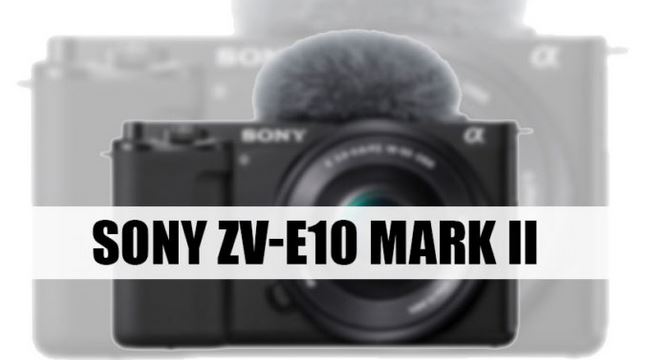
According to the latest tip, Sony is gearing up for an Camera announcement in July Month, ready to send NDA to the press and samples for creating content, before they make the official announcement. The source told us, “The most awaited Sony camera is set to come next month. Press kits are prepared, and NDA forms will be sent to press members and reviewers shortly” So, we are expecting the announcement Sony ZV-E10 Mark II next month.
Since, Expecting a Sony A7V announcement next month isn’t that logical, as well as any other Sony mirrorless camera for now.
source is new so take it with grain of salt.
Follow us on our social pages FACEBOOK | TWITTER | INSTAGRAM, If you have time –>see more Camera News and Sony Alpha Rumor
By admin, on April 6th, 2024
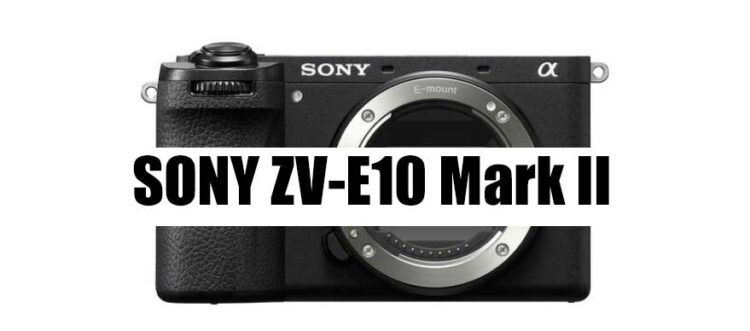
According to the latest rumors, the Nikon Z6 Mark 3 camera with a minor update and the Sony ZV-E10 Mark II camera, possibly with a 26-megapixel APS-C CMOS sensor (Same as the Sony A6700), will arrive in June 2024 as per the latest set of rumors we have.
Sony lenses that include 16 to 25 mm f/2.8 are coming on April 16 to 17, and the ZV-E10 Mark II camera is expected to arrive in the month of June 2024. Other than that, we are also expecting the announcement of the 85 mm f/1.4 G Master Mark 2 lens as well as the highly rumored 24 to 70 mm f/2 lens in the near future.
- 26MP Exmor R APS-C BSI CMOS Sensor
- BIONZ XR Image Processor
- UHD 4K 120p / FHD 240p / 10-Bit 4:2:2
- Up to 11-fps Shooting, ISO 100-32000
- Real-Time Tracking AF for Stills & Video
- 759-Point Phase Detection, 93% Coverage
- S-Log3, S-Gamut3, S-Cinetone, User LUTs
- Internal Mic + Inputs, USB Streaming
- 3″ 1.03m-Dot Vari-Angle LCD Touchscreen
- Price $798 [Bodly Only] | $899 With 16-50mm Lens | $1199 Creator Kit (Wireless grip + Shotgun Mic) | $1399 with 10-20mm Lens
Inventory or upcoming Sony E-mount autofocus lenses:
Sony FE 16-25mm F2.8 GM, to be released on April 16/17.
Sony FE 24-70mm F2.0, release date to be determined.
Sony FE 85mm F1.4 GM II, expected to be released in June 2024.
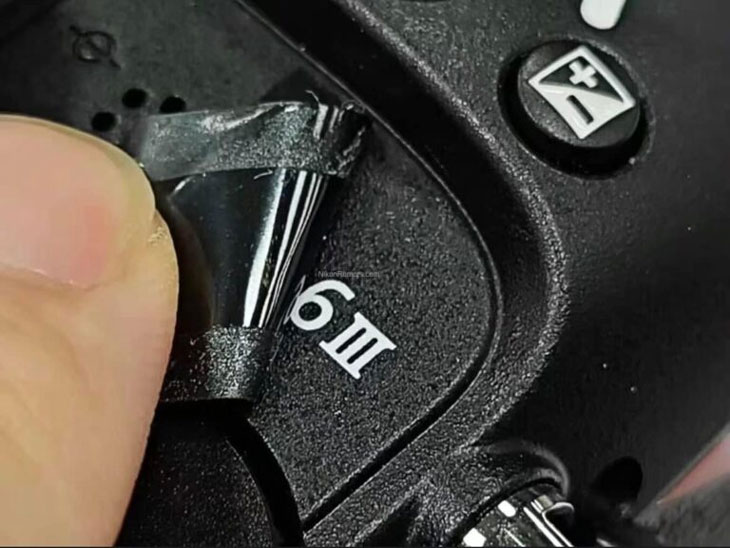
According to the latest reports coming out, the Nikon Z6 Mark III camera may have a minor update to save the sales of the Nikon ZF camera. We published a rumored set of specifications back on March 21st, 2024, and a Nikon dealer from China leaked that particular specification. Now, other rumor mills have also started to reshare the same specification that was already shared by our website months ago, stating that the camera will have a minor update. So, we can assume some kind of confirmation that the Z6 Mark 3 camera may have the same sensor and minor update over the Z6 Mark 2.
Nikon Z6 Mark III specification
Pixels: 24.5 million pixels
Processor: EXPEED7 processor
Anti-shake: Level 7 anti-shake
Shutter speed: 1/16000 second
AF: 299 points
Video: 6K/60p&4K/120p 12bit N-RAW recording
4KH.265 10Bit MOV video, can be 6K oversampled 4K
FX format or DX format up to 120p.
Continuous shooting: up to 40fps FX format, 120fps DX format continuous shooting
Viewfinder: Brand new high-resolution viewfinder with 5.76 million pixels
Card slot: support CFexvressB, SD UHS-II
Battery: EL-15 battery
Set up a warm association of photographers
Additional Specs
other
Pixel displacement high-resolution photography
Easy-to-use multi-angle LCD screen
Fine shutter angle options, split the project pause rate from the shooting pause rate
Support WiFi2.4/5GHZ, Bluetooth LE connection
USB-C fast charge & HDMI Type-A connection
Inherited from the Z8 style body, smaller than the Z8
Top micro-label (same as Z8 and Z9)
PASM dial pad
Stay tuned more updates are coming
Follow us on our social pages FACEBOOK | TWITTER | INSTAGRAM to get live news + Nikon Rumors 24X7.
source webio
By admin, on March 26th, 2024
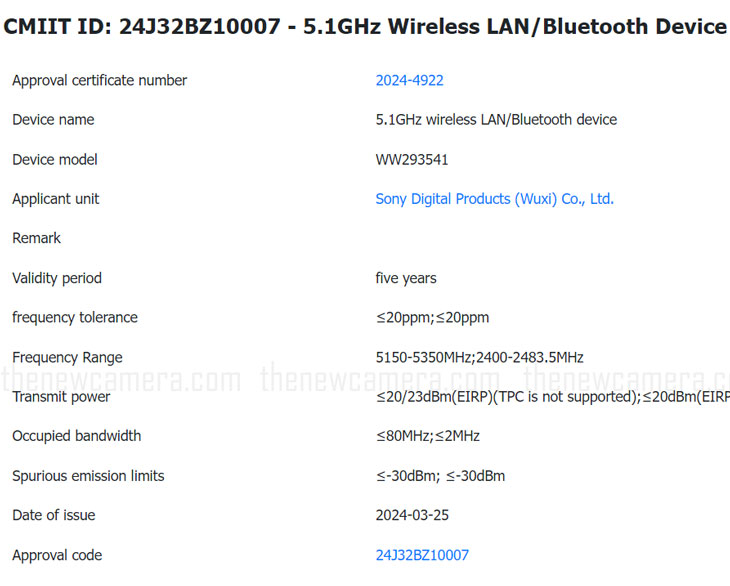
Sony registered a new camera at a wireless certification agency, the model code is WW293541. As per the latest rumors from rumor mills the WW293541 camera is said to be Sony ZV-E10 Mark II.
The only thing that concerns me is the WiFi band mentioned in the wireless certification document, since the Sony ZV-E10 series is an entry-level camera series and I was expecting Sony to keep WiFi limited to 2.4 GHz. But, in the latest registered model, we have 5 GHz WiFi available for faster data transfer which is usually available in Sony Cameras with $1000+ budget, like Sony A6700.
It looks like the Sony ZV-E10 Mark II comes with almost all the core specs we have seen in the Sony A6700 camera, including a 26MP sensor and 4k 60fps recording and of course 2.4 GHz and 5 GHz bands for fast and stable data transfer. (obviously, they will remove EVF and some features to save up the production line cost and sales of the A6700 camera)
Follow us on our social pages FACEBOOK | TWITTER | INSTAGRAM, If you have time –>see more Camera News and Sony Alpha Rumor
By admin, on December 14th, 2023

According to the latest set of rumors we have from the rumor mill, the Sony ZV-E10 Mark II camera will have the same 26-megapixel APS-C sensor that we have seen in the Sony A6700 camera. Most of the core specs of the A6700 camera will arrive in the successor of the ZV-E10, including a dedicated AI chip, and 4K recording up to 120fps. The only two things that we will miss in the Sony ZV-E10 Mark 2 are the sensor-shift image stabilization of the A6700 camera as well as the electronic viewfinder. But having this set of core specifications indicates it’s not coming in the same price range as the ZV-E10 camera for sure. It will have a higher price range as the ZV-E10 will remain in its position price-wise. So actually, there is no true successor to the Z10 camera coming right now.
- 26MP Exmor R APS-C BSI CMOS Sensor
- BIONZ XR Image Processor
- UHD 4K 120p / FHD 240p / 10-Bit 4:2:2
- Up to 11-fps Shooting, ISO 100-32000
- Real-Time Tracking AF for Stills & Video
- 759-Point Phase Detection, 93% Coverage
- S-Log3, S-Gamut3, S-Cinetone, User LUTs
- Internal Mic + Inputs, USB Streaming
- 3″ 1.03m-Dot Vari-Angle LCD Touchscreen
- Price $798 [Bodly Only] | $899 With 16-50mm Lens | $1199 Creator Kit (Wireless grip + Shotgun Mic) | $13999 with 10-20mm Lens
We will post more updates as soon as we get any.
Follow us on our social pages FACEBOOK | TWITTER | INSTAGRAM, If you have time –>see more Sony Alpha Rumor
By admin, on July 26th, 2023

Sony ZV-E10 Mark II OR Sony ZV-E20 is expected to arrive before October 2023. According to the latest rumors coming out from the rumor mill, an accessory maker accidentally published the ZV-E20 accessory in their product catalog list. But unfortunately, the rumor mill did not publish any supporting images or screenshots to verify the information they have published , so take it with a grain of salt.
UPDATE @ 26 July 2023
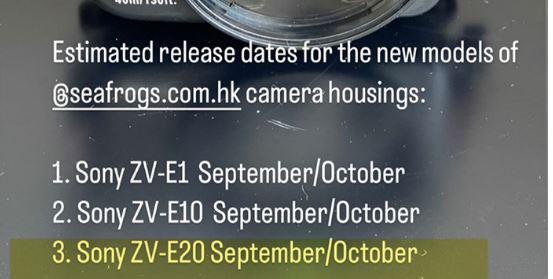
Finally, we have the image of the accessory maker that accidentally leaked the name of the Sony ZV-E20 camera. The accessory maker is C-Frog, which specializes in making waterproof cases for cameras. So, finally, we do have a strong lead. Now we have to wait for further confirmation.”
We will publish more updates as soon as they become available to us.
Follow us on our social pages FACEBOOK | TWITTER | INSTAGRAM, If you have time –>see more Sony Alpha Rumor
source addict
|
KEEP THIS BLOG ALIVE - Support New Camera Buy Canon Lenses, Buy Music CD or Digital Camera at amazon it helps this site, and you do not pay anything extra, it is just a way to help support this site.

|








 Lower cost at $649 body-only or $849 with kit lens – excellent value for features.
Lower cost at $649 body-only or $849 with kit lens – excellent value for features. Limited native RF-S lens options can increase long-term costs.
Limited native RF-S lens options can increase long-term costs.











